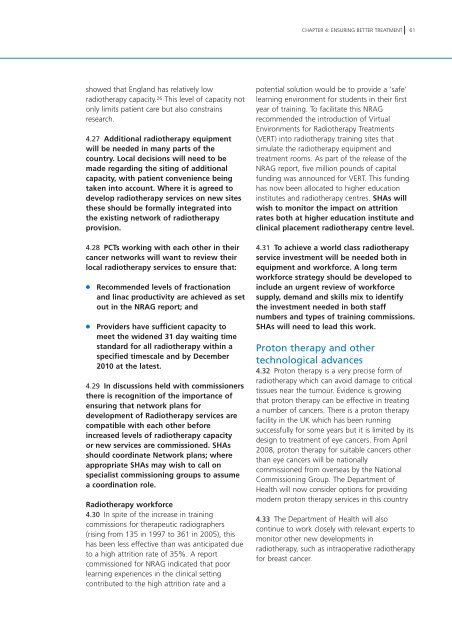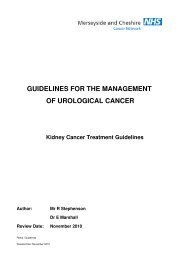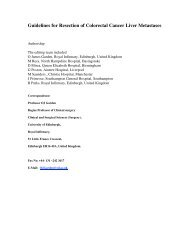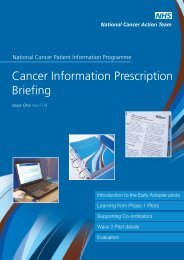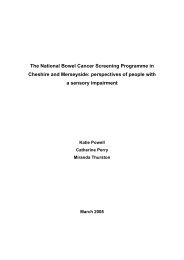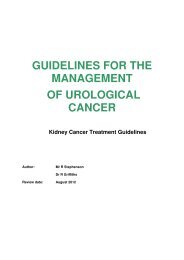Cancer Reform Strategy - NHS Cancer Screening Programmes
Cancer Reform Strategy - NHS Cancer Screening Programmes
Cancer Reform Strategy - NHS Cancer Screening Programmes
- No tags were found...
You also want an ePaper? Increase the reach of your titles
YUMPU automatically turns print PDFs into web optimized ePapers that Google loves.
CHAPTER 4: ENSURING BETTER TREATMENT 61showed that England has relatively lowradiotherapy capacity. 26 This level of capacity notonly limits patient care but also constrainsresearch.4.27 Additional radiotherapy equipmentwill be needed in many parts of thecountry. Local decisions will need to bemade regarding the siting of additionalcapacity, with patient convenience beingtaken into account. Where it is agreed todevelop radiotherapy services on new sitesthese should be formally integrated intothe existing network of radiotherapyprovision.4.28 PCTs working with each other in theircancer networks will want to review theirlocal radiotherapy services to ensure that:●●Recommended levels of fractionationand linac productivity are achieved as setout in the NRAG report; andProviders have sufficient capacity tomeet the widened 31 day waiting timestandard for all radiotherapy within aspecified timescale and by December2010 at the latest.4.29 In discussions held with commissionersthere is recognition of the importance ofensuring that network plans fordevelopment of Radiotherapy services arecompatible with each other beforeincreased levels of radiotherapy capacityor new services are commissioned. SHAsshould coordinate Network plans; whereappropriate SHAs may wish to call onspecialist commissioning groups to assumea coordination role.Radiotherapy workforce4.30 In spite of the increase in trainingcommissions for therapeutic radiographers(rising from 135 in 1997 to 361 in 2005), thishas been less effective than was anticipated dueto a high attrition rate of 35%. A reportcommissioned for NRAG indicated that poorlearning experiences in the clinical settingcontributed to the high attrition rate and apotential solution would be to provide a ‘safe’learning environment for students in their firstyear of training. To facilitate this NRAGrecommended the introduction of VirtualEnvironments for Radiotherapy Treatments(VERT) into radiotherapy training sites thatsimulate the radiotherapy equipment andtreatment rooms. As part of the release of theNRAG report, five million pounds of capitalfunding was announced for VERT. This fundinghas now been allocated to higher educationinstitutes and radiotherapy centres. SHAs willwish to monitor the impact on attritionrates both at higher education institute andclinical placement radiotherapy centre level.4.31 To achieve a world class radiotherapyservice investment will be needed both inequipment and workforce. A long termworkforce strategy should be developed toinclude an urgent review of workforcesupply, demand and skills mix to identifythe investment needed in both staffnumbers and types of training commissions.SHAs will need to lead this work.Proton therapy and othertechnological advances4.32 Proton therapy is a very precise form ofradiotherapy which can avoid damage to criticaltissues near the tumour. Evidence is growingthat proton therapy can be effective in treatinga number of cancers. There is a proton therapyfacility in the UK which has been runningsuccessfully for some years but it is limited by itsdesign to treatment of eye cancers. From April2008, proton therapy for suitable cancers otherthan eye cancers will be nationallycommissioned from overseas by the NationalCommissioning Group. The Department ofHealth will now consider options for providingmodern proton therapy services in this country4.33 The Department of Health will alsocontinue to work closely with relevant experts tomonitor other new developments inradiotherapy, such as intraoperative radiotherapyfor breast cancer.


